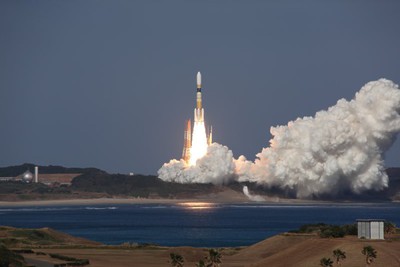 |
A Japanese H-IIB (H-2-B) rocket launched from the Tanegashima Space Center.
Courtesy of JAXA |
| |
Tanegashima Space Center, Japan - January 22, 2011
Japan Aerospace Exploration Agency (JAXA)
and
Mitsubishi Heavy Industries, Ltd.
The Japan Aerospace Exploration Agency (JAXA) launched the
H-IIB Launch Vehicle No.2 (H-IIB F2) with the KOUNOTORI2 (HTV2), a cargo transfer vehicle to the
International Space Station, onboard at 2:37:57 p.m. on January 22, 2011 (Japan Standard Time, JST) from the
Tanegashima Space Center.
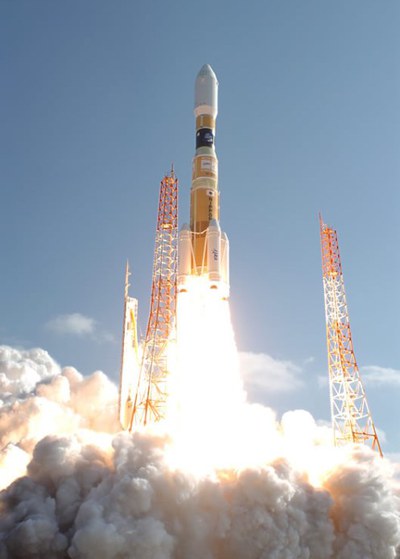 |
A Japanese H-IIB (H-2-B) rocket launched from the Tanegashima Space Center.
Courtesy of JAXA |
| |
The launch vehicle flew smoothly, and, at about 15 minutes and 13 seconds after liftoff, the separation of the
KOUNOTORI2 was confirmed.
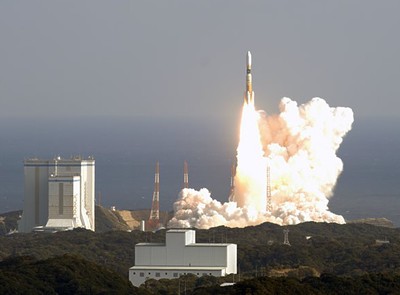 |
A Japanese H-IIB (H-2-B) rocket launched from the Tanegashima Space Center.
Courtesy of JAXA |
| |
We would like to express our profound appreciation for the cooperation and support of all related personnel and organizations that helped contribute to the
successful launch of the H-IIB F2.
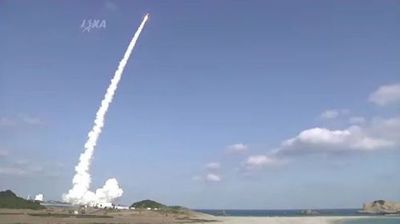 |
A Japanese H-IIB (H-2-B) rocket launched from the Tanegashima Space Center.
Photo from YouTube JAXA Channel |
| |
At the time of the launch, the weather was clear, a wind speed was 8.3 meters/second from the north-west and the temperature was 10.6 degrees Celsius.
KOUNOTORI2 Separates from the H-IIB Second Stage
Separations of the
Solid Rocket Booster (SRB-A), the Fairing, the
H-IIB First Stage occurred just as planned.
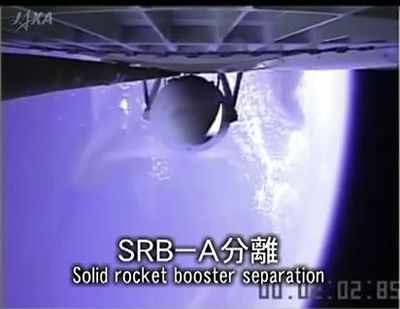 |
| Photo from YouTube JAXA Channel |
| |
The H-IIB Second Stage burned out approximately 15 minutes after launch, and the
KOUNOTORI2 was successfully separated from the
H-IIB Second Stage.
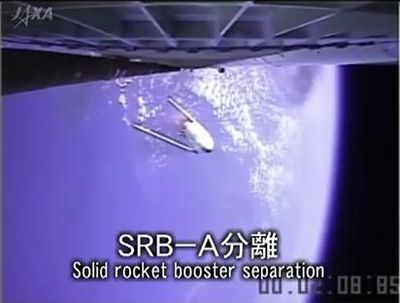 |
| Photo from YouTube JAXA Channel |
| |
Then, the
KOUNOTORI2 was inserted into the planned initial orbit.
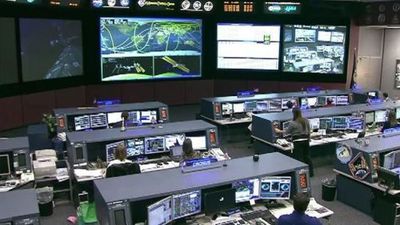 |
The NASA's TDRS
Photo from YouTube JAXA Channel |
| |
KOUNOTORI2 Initiates Communications with Tsukuba (HTV MCR)
The KOUNOTORI2 has successfully established communications with the
NASA's TDRS, and initiated communications with the
HTV Mission Control Room (HTV MCR) at the
Tsukuba Space Center (TKSC).
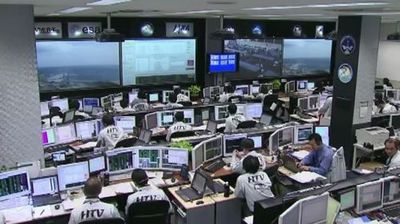 |
JAXA – Tsukuba Space Center
Photo from YouTube JAXA Channel |
| |
The
KOUNOTORI2 also established two-axis attitude.
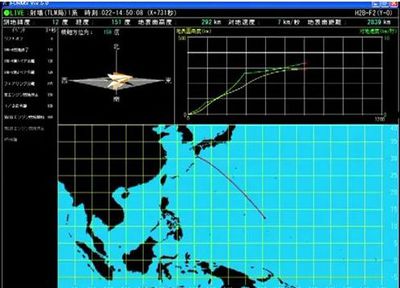 |
|
Photo from YouTube JAXA Channel
|
| |
KOUNOTORI2 Establishes Three-Axis Attitude
KOUNOTORI2 Establishes Three-Axis Attitude (January 22, 2011)
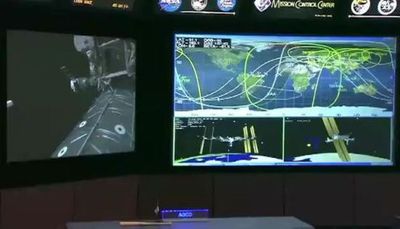 |
The NASA's TDRS
Photo from YouTube JAXA Channel |
| |
The
KOUNOTORI2 has successfully established three-axis attitude at 3:36 p.m. January 22.
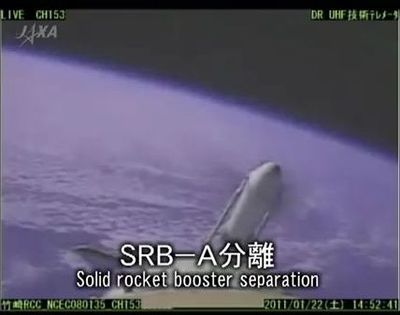 |
| Photo from YouTube JAXA Channel |
| |
KOUNOTORI's system self-checks are ongoing in preparation for its first phase adjusting maneuver (Phase Maneuver1: PM1) scheduled at 10:08 p.m. January 22.
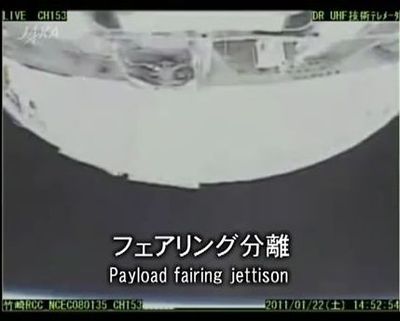 |
| Photo from YouTube JAXA Channel |
| |
KOUNOTORI2 Completes the First Phase Maneuver (PM1)
The
KOUNOTORI2 completed the first
Phase Maneuver (PM1) at 10:13 p.m., January 22.
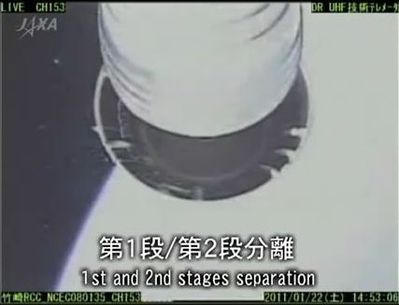 |
| Photo from YouTube JAXA Channel |
| |
Next
HTV2 mission status update will be posted on Monday morning, January 24, 2011.
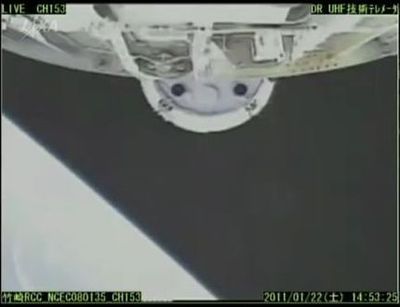 |
| Photo from YouTube JAXA Channel |
| |
The
KOUNOTORI2 will fly to the
ISS, then, on
January 28, 2011 (JST,) it is slated for berthing with the
ISS.
HTV2 Mission
On the
HTV2 Mission, JAXA’s H-II Transfer Vehicle (HTV), KONOTORI, will make the second flight to the
International Space Station (ISS).
During the
HTV1 Mission (September 2009), the
HTV maiden flight vehicle (HTV1) demonstrated its autonomous and remotely-controlled rendezvous capabilities while delivering cargo/supplies to the
ISS.
Having achieved the remarkable performance during the
HTV1 Mission, the
HTV2 Mission will focus on
ISS cargo transportation activities.
Mission Objectives
The HTV2 Mission’s primary objectives include launch of the
second H-IIB launch vehicle, cargo delivery to the ISS, and support of the station’s trash disposal.
After the
HTV1 Mission, some modifications were made to
HTV’s original configuration and operational procedures based on the
HTV1 mission results.
During the
HTV2 Mission, performances of the modified parts will be monitored.
Major modifications are as follows.
HTV Pressurized Logistics Module (PLC)
• Cargo loading capacity of the HTV Re-supply Rack (HRR) was increased by modifying its cargo layout
• Cargo capacity of the PLC was increased by creating additional cargo spaces inside the PLC
• Of four lights inside the PLC, two lights were replaced to domestic (Japanese) LED lights.
Avionics Module
• The total number of onboard batteries was reduced. In addition, the onboard batteries were upgraded
• Onboard rendezvous flight software was modified
• Space Integrated GPS/Inertial Navigation System (SIGI) software was modified
• Proximity Link System String B transponder was replaced to a domestic (Japanese) transponder
Propulsion Module
• Some of the injection temperature sensors on the HTV’s Reaction Control System (RCS) thrusters were modified to increase the upper measurement range
Payload (Cargo)
The
HTV2 delivers approximately
5,300 kg of cargo to the ISS.
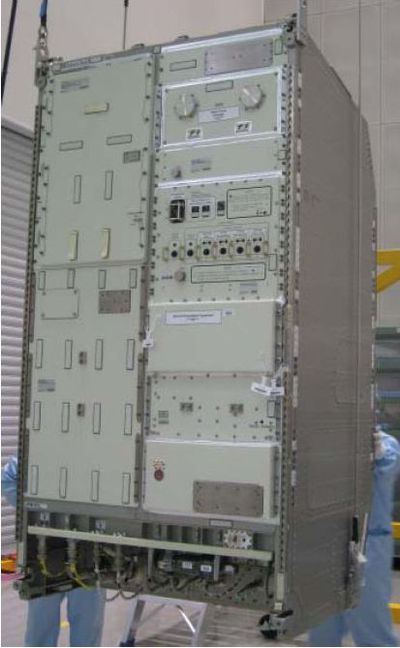 |
KOBAIRO Rack (before Installation to the HTV PLC)
Courtesy of JAXA |
| |
For pressurized cargo, the
HTV2 delivers JAXA’s two science racks, KOBAIRO Rack and the Multi-purpose Small Payload Rack (MSPR).
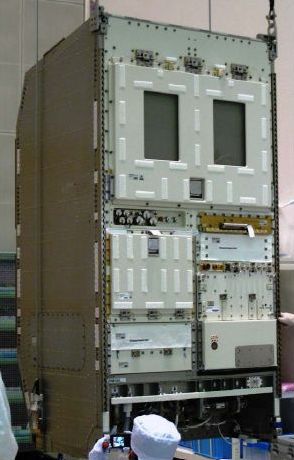 |
Multi-purpose Small Payload Rack (MSPR)
Courtesy of JAXA |
| |
This is the first time that the
HTV delivers
JAXA’s science experiment rack to the ISS.
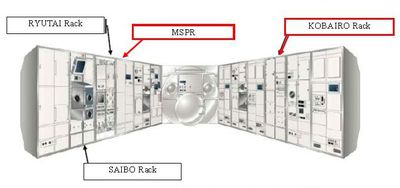 |
Layout of the Science Racks on board Kibo
Courtesy of JAXA |
| |
In addition, the
HTV2 Mission delivers potable
water to the ISS.
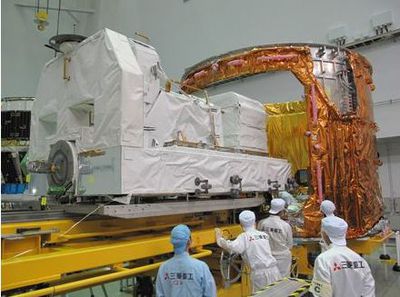 |
HTV Exposed Pallet (EP)
Courtesy of JAXA |
| |
For unpressurized cargo, the
HTV2 delivers NASA’s two Orbital Replacement Units (ORUs), the Cargo Transport Container (CTC) and the Flex Hose Rotary Coupler (FHRC), to the ISS.
These unpressurized
ORUs will be stored outside of the
ISS for later use.
The HTV2 Mission Major Events
On the
HTV2 Mission, the
HTV will be berthed to the
ISS on FD8.
While the
HTV stays at the
ISS, supply/cargo transfer between the
HTV and the
ISS will be performed.
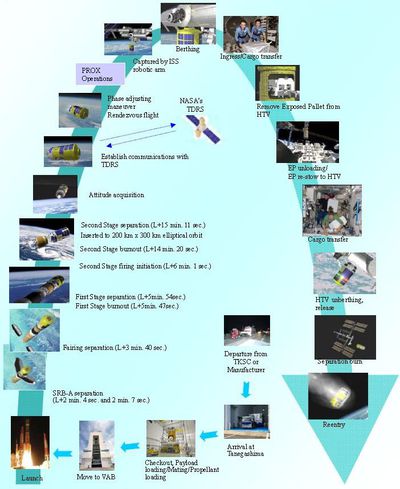 |
HTV1 Mission Event Sequence
Courtesy of JAXA |
| |
The
HTV will then be loaded with trash and used materials, and unberthed from the
ISS.
Finally, the
HTV will reenter the
Earth’s atmosphere.
HTV2 Operations Control
After separating from the H-IIB launch vehicle, the
HTV will automatically activate the
HTV subsystems, stabilize its attitude, and perform self-checks on the
HTV components.
Then, the
HTV will establish communications with the
TDRS and initiate communications with the
HTV MCR at TKSC.
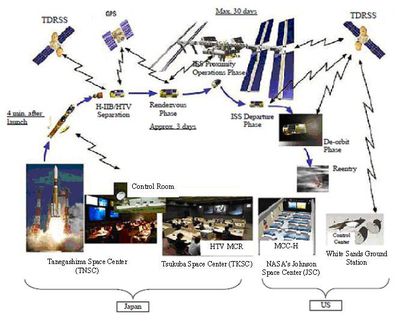 |
HTV Operation Control Overview
Courtesy of JAXA |
| |
Once communications between the
HTV and the
HTV MCR is established,
HTV flight control by the HTV MCR will begin.
The HTV MCR will monitor
HTV’s telemetry and flight data, and send commands for controlling the
HTV subsystems and maneuvering its flight.
From 90 minutes before the HTV reaches 5 km behind the ISS (Approach Initiation (AI) point), the HTV MCR and MCC-H will collaboratively operate the HTV mission.
SOURCE: Japan Aerospace Exploration Agency (JAXA)
http://www.jaxa.jp/countdown/h2bf2/index_e.html
http://iss.jaxa.jp/en/htv/mission/htv-2/
http://iss.jaxa.jp/en/htv/mission/htv-2/news/
Video
Japanese Cargo Ship Heads for the International Space Station
http://www.youtube.com/watch?v=svUMzW3kV1s&feature=related
Video
Japan successfully launch cargo rocket
http://www.youtube.com/watch?v=t34tSHeking&feature
Video
Launch of KOUNOTORI2/H-IIB F2
http://www.youtube.com/watch?v=H8xdk60m0ik&feature
ASTROMAN Magazine - 2011.01.07
A New Type of Launch Vehicle: A Rocket with Artificial Intelligence
http://www.astroman.com.pl/index.php?mod=magazine&a=read&id=872
ASTROMAN Magazine - 2010.07.01
NEC Satellite Systems. HAYABUSA's seven-year journey in space
http://www.astroman.com.pl/index.php?mod=magazine&a=read&id=753

